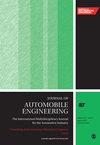根据驾驶风格提供个性化操控稳定性约束的路径跟踪功能
IF 1.5
4区 工程技术
Q3 ENGINEERING, MECHANICAL
Proceedings of the Institution of Mechanical Engineers Part D-Journal of Automobile Engineering
Pub Date : 2024-05-10
DOI:10.1177/09544070241248557
引用次数: 0
摘要
在路径跟踪控制过程中,驾驶员对车辆的横向响应有不同的期望。为了满足驾驶员对操纵稳定性的期望,本文提出了一种基于模型预测控制(MPC)的路径跟踪控制器,该控制器具有与驾驶风格相匹配的个性化操纵稳定性约束。首先,通过对收集到的驾驶数据应用 K-Means 算法获得驾驶风格类别。然后,根据车辆的非线性动力学模型构建侧倾角-纵向速度图,生成与不同风格驾驶员所期望的车辆最大侧倾相匹配的前轮转向角约束。然后,建立基于 MPC 的路径跟踪控制器,并将前轮转向角纳入 MPC 控制器。此外,与直接使用侧倾角约束进行操纵稳定性控制的策略相比,这种方法避免了引入额外的约束变量,从而提高了实时性。通过仿真实验,比较了考虑驾驶风格的操纵稳定性控制与不考虑驾驶风格的控制系统之间的车辆动态响应。此外,还进行了主观评价,以验证所提出的考虑驾驶风格稳定性约束的路径跟踪控制方法。评价结果表明,与不考虑驾驶风格的路径跟踪控制器相比,所提出的方法能获得更好的主观评价结果。最后,通过硬件在环实验,验证了所提控制器的实时计算能力。本文章由计算机程序翻译,如有差异,请以英文原文为准。
Path tracking with personalized handling stability constraints matched to driving styles
In the path-tracking control process, drivers have different expectations of the lateral response of vehicles. To meet drivers’ expectations of handling stability, this paper proposes a model predictive control (MPC)-based path-tracking controller with personalized handling stability constraints matched to driving style. Firstly, the categories of driving styles are obtained by applying the K-Means algorithm to the collected driving data. Then the sideslip angle-longitudinal velocity map is constructed based on the nonlinear dynamics model of the vehicle to generate the front-wheel steering angle constraints that are matched with the maximum sideslip of the vehicle expected by drivers of different styles. After that, an MPC-based path-tracking controller has been built, and the front-wheel steering angle is incorporated into the MPC controller. Furthermore, compared to the strategy of directly using sideslip angle constraints for handling stability control, this approach avoids introducing additional constraint variables, leading to improved real-time performance. Simulation experiments are conducted to compare the dynamic vehicle responses between the handling stability control that takes into account the driving style and the control system that does not consider the driving style. In addition, the subjective evaluation is conducted to verify the proposed path-tracking control method that considers the stability constraints of driving style. The evaluation results show that the proposed method can obtain better subjective evaluation results than a path-tracking controller that does not consider the driving style. Finally, through the hardware-in-the-loop experiments, the real-time computational capability of the proposed controller is verified.
求助全文
通过发布文献求助,成功后即可免费获取论文全文。
去求助
来源期刊

CiteScore
4.40
自引率
17.60%
发文量
263
审稿时长
3.5 months
期刊介绍:
The Journal of Automobile Engineering is an established, high quality multi-disciplinary journal which publishes the very best peer-reviewed science and engineering in the field.
 求助内容:
求助内容: 应助结果提醒方式:
应助结果提醒方式:


